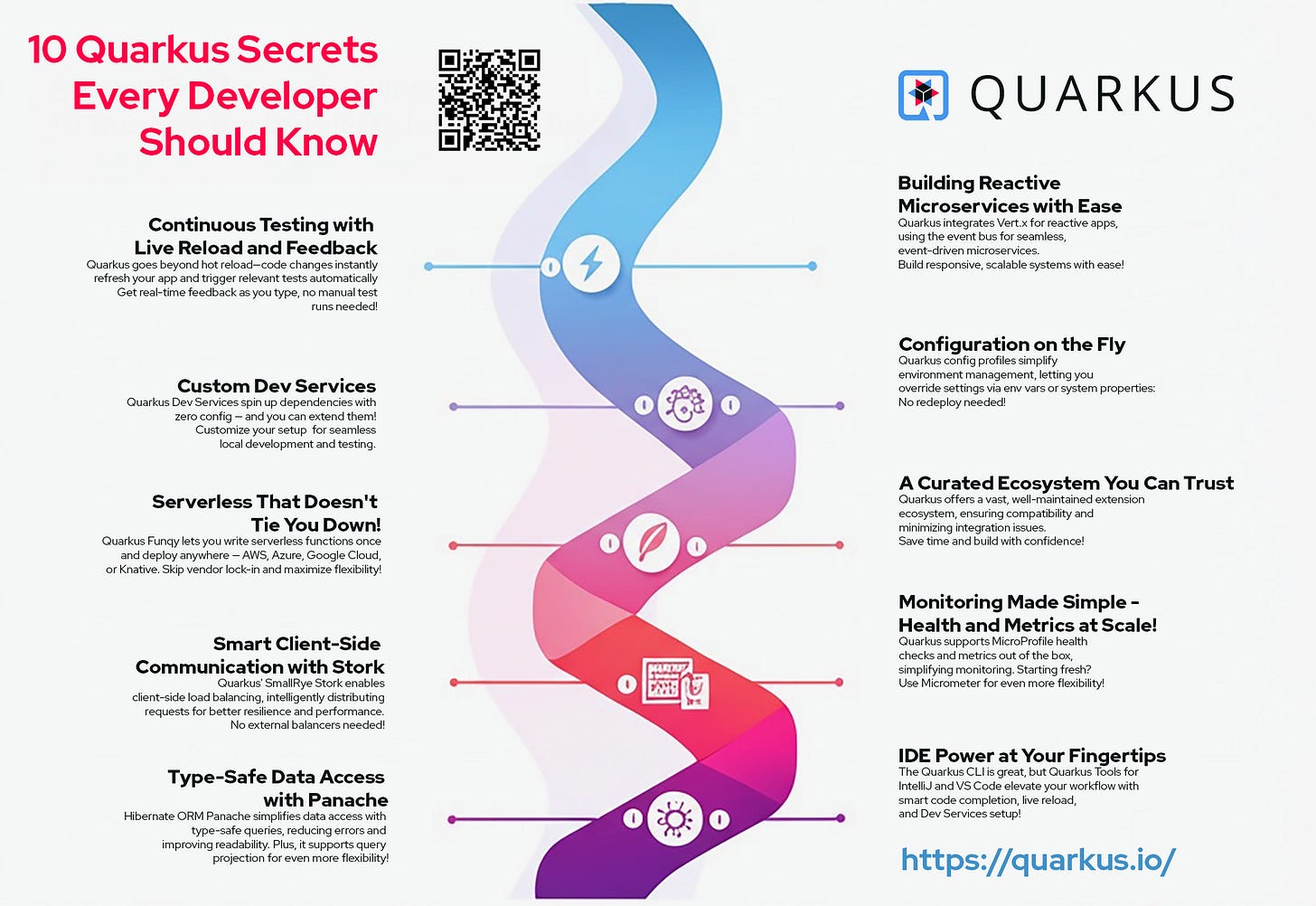Beyond the Buzzwords: 10 Quarkus Secrets Every Developer Should Know
Go beyond the basics with these 10 lesser-known Quarkus features that will supercharge your development workflow and application capabilities.
We all know Quarkus for its lightning-fast startup times and its ability to build lean, mean native executables. These are the headline features that often steal the spotlight. But beneath the surface, Quarkus also contains a collection of clever features and design choices that can significantly improve your development experience and application capabilities.
Forget the usual suspects. Let's take a look at 10 less-talked-about aspects of Quarkus that can truly make a difference in your daily coding life.
1. Continuous Testing with Live Reload and Feedback
Hot reload is a developer's best friend, instantly reflecting code changes in a running application. But Quarkus takes this a step further. Imagine this: you tweak a line of code, and in the blink of an eye, not only does your application refresh, but your relevant tests also automatically execute in the background. The Quarkus development UI becomes your real-time feedback center, highlighting successes and pinpointing failures as you type. No more context switching or manual test runs – just continuous validation. Learn more about it in the continuous testing guide!
2. Craft Your Own Development Playground
Dev Services are fantastic for spinning up dependencies like databases with zero configuration. But did you know you can easily extend this functionality? If you're working with a niche technology or require a very specific setup for local development, Quarkus allows you to create your own Dev Services. This means you can tailor your development environment precisely to your needs, making integration testing and local debugging a breeze. Get started writing your own Dev Service!
3. Serverless That Doesn't Tie You Down - Funqy!
Quarkus' Funqy extension simplifies building serverless functions. However, its true strength lies in its abstraction capabilities. Write your function code once using the Funqy model, and you can deploy it to various cloud providers – AWS Lambda, Google Cloud Functions, Azure Functions, or even Knative – with minimal changes. This portability saves you from vendor lock-in and offers incredible deployment flexibility. If that isn’t funqy, I don’t know what is. Try it out!
4. Smart Client-Side Communication with Stork
We often think about server-side load balancing, but what about the client? Quarkus includes SmallRye Stork, a framework for client-side load balancing and service discovery. In scenarios where you have multiple instances of a service, Stork allows your application to intelligently distribute requests, improving resilience and performance without relying solely on external load balancers. Learn more about Stork!
5. Type-Safe Data Access with Panache
Hibernate ORM Panache simplifies database interactions. While its active record style is well-known, the power of its query capabilities, especially with generics, often goes unnoticed. Instead of relying on string-based JPQL queries, Panache allows you to write type-safe queries, catching potential errors at compile time and making your data access code more robust and readable. It also does query projection on top! Learn all about it and dig into the details of Hibernate ORM with Panache!
// Instead of:
// List<Person> people = em.createQuery("SELECT p FROM Person p WHERE p.status = :status", Person.class)
// .setParameter("status", Status.Alive)
// .getResultList();
// With Panache:
PanacheQuery<Person> query = Person.find("status", Status.Alive).project(Person.class);
6. Building Reactive Microservices with Ease
Quarkus leverages Vert.x, a toolkit for building reactive applications. Beyond just handling HTTP requests reactively, Quarkus deeply integrates with the Vert.x event bus. This provides a lightweight and efficient mechanism for building asynchronous and event-driven microservices within your application. Imagine different parts of your application communicating seamlessly through events, leading to more responsive and scalable systems. Make sure to check out the Vert.x event bus guide.
7. Configuration on the Fly
Quarkus' configuration profiles are excellent for managing different environments. But a less obvious yet incredibly useful feature is the ability to override configuration properties using environment variables and system properties without recompiling your application. This is totally changing how you implement deployment scenarios where you need to adjust settings quickly without redeploying the entire application. There is a complete configuration reference guide waiting for you to check it out!
8. A Curated Ecosystem You Can Trust
The sheer number of extensions in the Quarkus ecosystem is impressive. What's even more valuable is the active curation and maintenance by the Quarkus team. This focus on quality and compatibility means you can generally rely on extensions to work well together, reducing the risk of unexpected integration issues and saving you valuable debugging time. Also check out how community extensions are released. It is an interesting read!
9. Monitoring Made Simple - Health and Metrics at Scale!
Quarkus embraces the MicroProfile specifications, providing built-in support for health checks and metrics through standardized /health and /metrics endpoints. This means you get essential monitoring capabilities with minimal effort, making it easy to integrate with various monitoring tools and platforms to keep a pulse on your application's health and performance. Make sure to read the health and metrics endpoint documentation! Oh, and while you’re thinking about metrics. If you start over and don’t require MicroProfile compatibility, make sure to switch to Micrometer!
10. IDE Power at Your Fingertips:
The Quarkus CLI is a handy tool, but the Quarkus Tools for IDEs like IntelliJ IDEA and VS Code take the developer experience to another level. Beyond basic project generation, these tools offer features like intelligent code completion for Quarkus annotations, seamless integration with live reload, and even assistance in setting up Dev Services. This tight IDE integration streamlines your workflow and makes development even more efficient.
So, the next time you're working with Quarkus, remember these often-overlooked features. They are testaments to the framework's commitment to developer productivity and application robustness, proving that there's always more to discover beyond the initial buzz.




